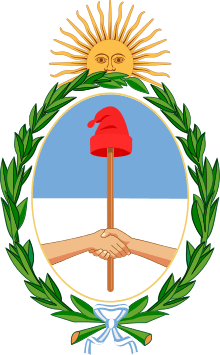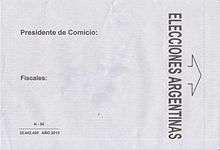Elections in Argentina
 |
| This article is part of a series on the politics and government of Argentina |
| Foreign relations |
This article is about voting, elections, and election results in Argentina. For details of Argentine government institutions and political parties, see Politics of Argentina.
At the national level, Argentina elects a head of state (the President) and a legislature. The franchise extends to all citizens aged 16 and over, and voting is mandatory (with a few exceptions) for all those who are between 18 and 70 years of age.
The President and the Vice-President are elected in one ballot, for a four-year term, by direct popular vote, using a runoff voting system: there must be a second round if no formula gets more than 45% of the affirmative valid votes, or more than 40% of the affirmative valid votes with a difference of 10 percentage points from the second formula, in quantity of affirmative valid votes. Before the 1995 election, the President and Vice-President were both elected by an electoral college.
The National Congress (Congreso Nacional) has two chambers. The Chamber of Deputies of the Nation (Cámara de Diputados de la Nación) has 257 members, elected for a four-year term in each electoral district (23 Provinces and the Autonomous city of Buenos Aires) by proportional representation using the D'Hondt method, with half of the seats renewed every two years in all districts. The Senate of the Nation (Senado de la Nación) has 72 members, elected for a six-year term in three-seat constituencies (23 provinces and the Autonomous city of Buenos Aires) for a six-year term, with two seats awarded to the largest party or coalition and one seat to the second largest party or coalition. One-third of the constituencies are renewed every two years. In 2001 the whole senate was renewed. A quota law lays down that at least a third of the candidates on the ballots presented by each party participating in legislative elections must be women.
Schedule

Election
| Position | 2011 | 2012 | 2013 | 2014 | 2015 |
|---|---|---|---|---|---|
| Type | Open Primaries[note 1] (August) Presidential (October) National Senate (October) Chamber of Deputies (October) Provincial (March-October) Municipalities (March-October) | Municipalities (no data) | Open Primaries (August) National Senate (October) Chamber of Deputies (October) Provincial (TBA) Municipalities (TBA) | Municipalities (no data) | Open Primaries (August) Presidential (October) National Senate (October) Chamber of Deputies (October) Provincial (March-October) Municipalities (March-October) |
| President and Vice-president |
President and Vice-president | None | President and Vice-president | ||
| National Senate | Third[note 2] | None | Third[note 3] | None | Third[note 4] |
| Chamber of Deputies | Half[note 5] | None | Half | None | Half |
| Provincial (Governors and Legislatures) |
22 Provinces (G)[note 6] 23 Provinces (L)[note 7] | None | 2 Provinces (G)[note 8] 13 Provinces (L)[note 9] | None | 22 Provinces (G)[note 10] 23 Provinces (L)[note 11] |
| Municipalities (Mayors and Councils) |
no data | no data | no data | no data | no data |
Inauguration
| Position | 2011 | 2012 | 2013 | 2014 | 2015 |
|---|---|---|---|---|---|
| Type | Presidential (December) National Senate Chamber of Deputies Provincial Municipalities | Municipalities | National Senate Chamber of Deputies Provincial Municipalities | Municipalities | Presidential National Senate Chamber of Deputies Provincial Municipalities |
| President and Vice-president |
10 December | None | 10 December | ||
| National Senate | 10 December | None | 10 December | None | 10 December |
| Chamber of Deputies | 10 December | None | 10 December | None | 10 December |
| Provinces (Governors and Legislatures) | December | None | December | None | December |
| Municipalities (Mayors and Councils) | no data | no data | no data | no data | no data |
Elections and results
Latest legislative elections
| Coalitions and parties | Chamber of Deputies of the Nation: 127 out of 257 seats |
Senate of the Nation: 24 out of 72 seats | ||||
|---|---|---|---|---|---|---|
| Votes | % | Deputies | Votes | % | Senators | |
| Justicialist Party | 2,778,326 | 14.50% | 19 | |||
| Front for Victory | 1,679,084 | 8.80% | 14 | |||
| Justicialist Front | 415,404 | 2.20% | 6 | - | ||
| Others | 1,018,515 | 5.30% | 8 | - | ||
| Total Kirchnerist (Left-wing Peronist) | 5,891,330 | 30.80% | 47 | 8 | ||
| Civic and Social Agreement | 3,794,853 | 19.80% | 28 | - | ||
| Radical Civic Union | 639,818 | 3.30% | 4 | - | ||
| Front for Everyone | 381,067 | 2.00% | 3 | - | ||
| Others | 734,009 | 3.84% | 6 | |||
| Total Civic and Social Agreement (Center-left radical) | 5,549.,747 | 28.94% | 41 | 14 | ||
| Republican Proposal (Liberal-conservative and right-wing factions opposed to Kirchner) |
3,391,391 | 17.70% | 20 | 0 | ||
| Proyecto Sur | 437,634 | 2.30% | 4 | |||
| New Encounter | 402,502 | 2.10% | 2 | |||
| Others | 255,566 | 1.30% | - | |||
| Total Left-wing (Socialist) | 1,092,702 | 5.70% | 6 | 0 | ||
| Others parties | 3,208,917 | 16.77% | 13 | 2 | ||
| Total | 19,134,087 | 127 | 24 | |||
| Registered voters | 27,797,930 | |||||
| Votes cast | 20,123,715 | |||||
| Invalid votes | 989,628 | 4.90% | ||||
| Sources: Adam Carr's Website [1] Be aware that parties operate under various labels and alliances in the provinces. | ||||||
2011 presidential election
| Candidate | Party or coalition | Votes | % | |
|---|---|---|---|---|
| Cristina Fernández de Kirchner | Front for Victory–PJ | 11,864,456 | 54.11% | |
| Hermes Binner | Broad Progressive Front–PS | 3,684,595 | 16.80% | |
| Ricardo Alfonsín | Union for the Social Development–UCR | 2,442,880 | 11.14% | |
| Alberto Rodríguez Saá | Federal Commitment–PJ | 1,745,303 | 7.96% | |
| Eduardo Duhalde | Popular Front–PJ | 1,285,783 | 5.86% | |
| Jorge Altamira | Workers Left Front–PO | 503,342 | 2.30% | |
| Elisa Carrió | Civic Coalition–CC ARI | 399,641 | 1.82% | |
| Blank votes | 678,724 | 3.03% | ||
| Null votes | 206,030 | 0.92% | ||
| Challenged votes | 23,921 | 0.11% | ||
| Turnout | 78.89% | |||
| Source: elecciones2011.gov.ar | ||||
2015 presidential election
Past elections
See also
Notes
- ↑ Simultaneous open primaries for all national candidatures, mandatory for every political party
- ↑ The following eight provinces renew all its three senators: Buenos Aires Province, Formosa, Jujuy, La Rioja, Misiones, San Juan, San Luis, Santa Cruz
- ↑ The following eight provinces renew all its three senators:Autonomous City of Buenos Aires, Chaco, Entre Ríos, Neuquén, Río Negro, Salta, Santiago del Estero and Tierra del Fuego
- ↑ The following eight provinces renew all its three senators: Catamarca, Chubut, Córdoba, Corrientes, La Pampa, Mendoza, Santa Fe and Tucumán
- ↑ All 23 provinces and the Autonomous City of Buenos Aires renew half its deputies
- ↑ All Provinces and the Autonomous City of Buenos Aires except for Corrientes and Santiago del Estero
- ↑ All Provinces and the Autonomous City of Buenos Aires except for Santiago del Estero
- ↑ Corrientes and Santiago del Estero
- ↑ Autonomous City of Buenos Aires, Buenos Aires Province, Catamarca, Chaco, Corrientes, Formosa, Jujuy, La Rioja, Mendoza, Misiones, Salta, San Luis and Santiago del Estero
- ↑ All Provinces and the Autonomous City of Buenos Aires except for Corrientes and Santiago del Estero
- ↑ All Provinces and the Autonomous City of Buenos Aires except for Santiago del Estero
External links
- Election Atlas of Argentina from 1983
- Adam Carr's Election Archive
- Argentina Elections 2007
- Argentina Elections 101